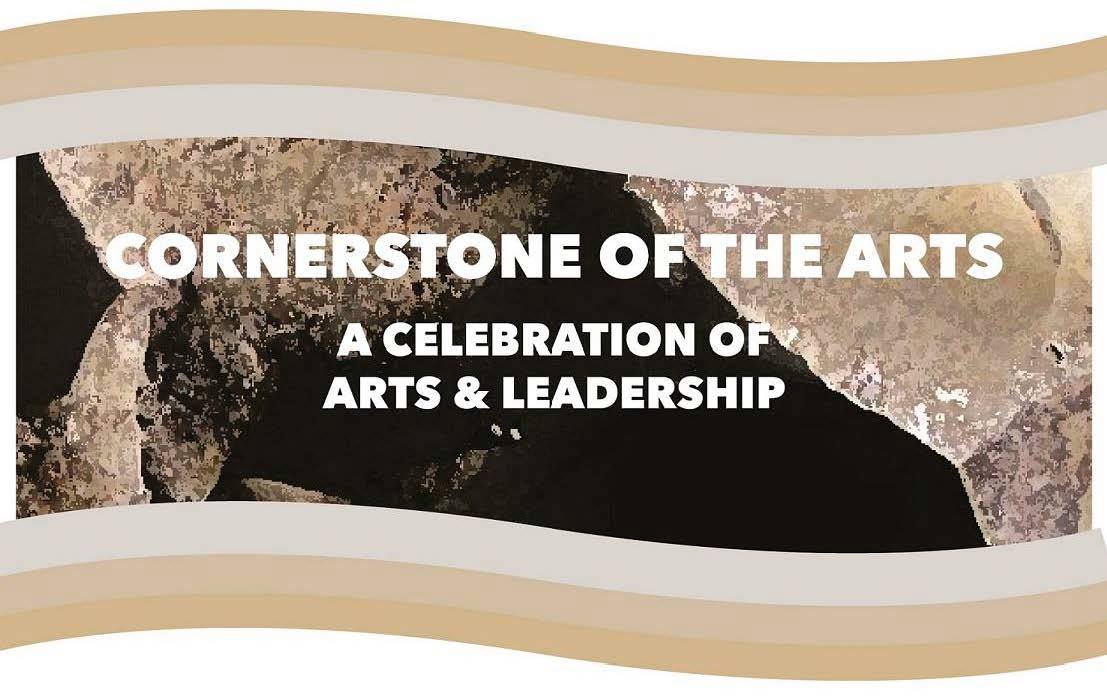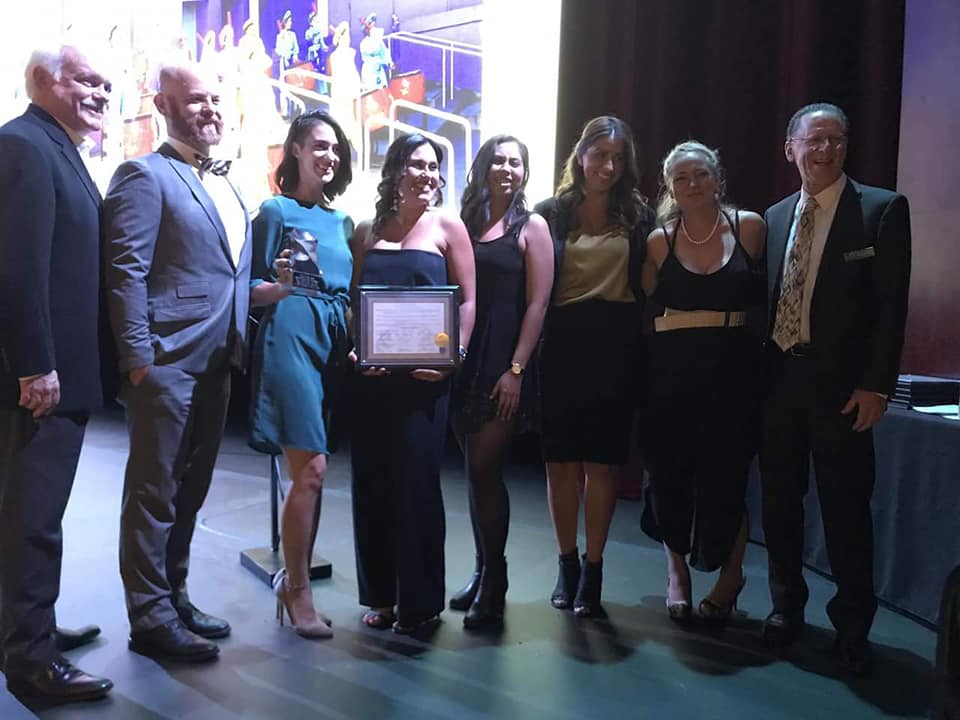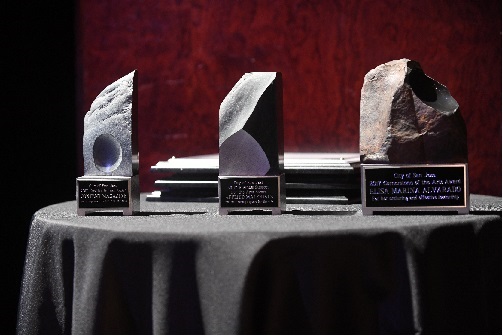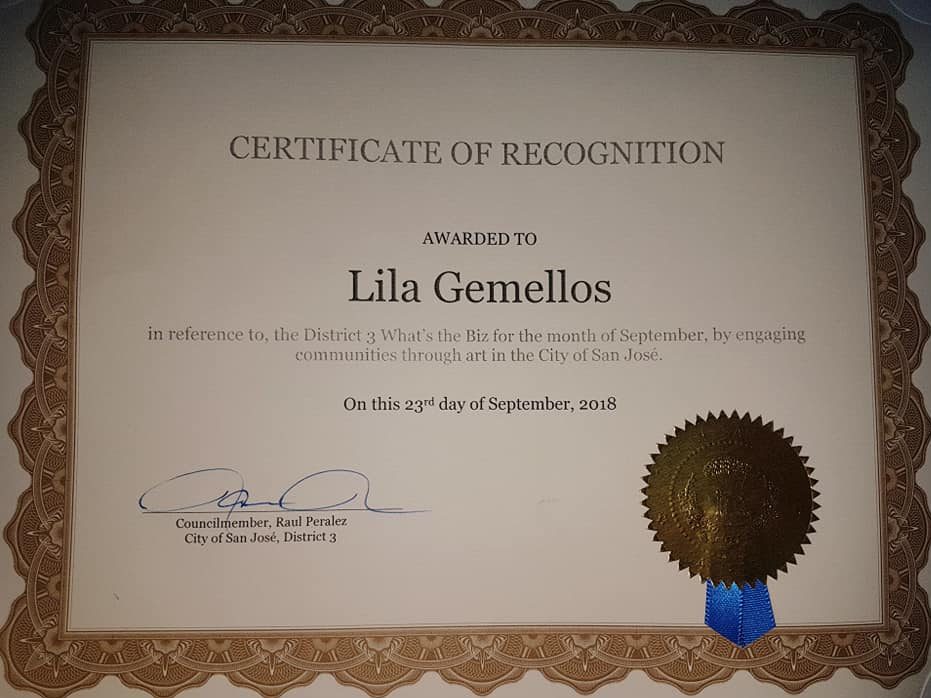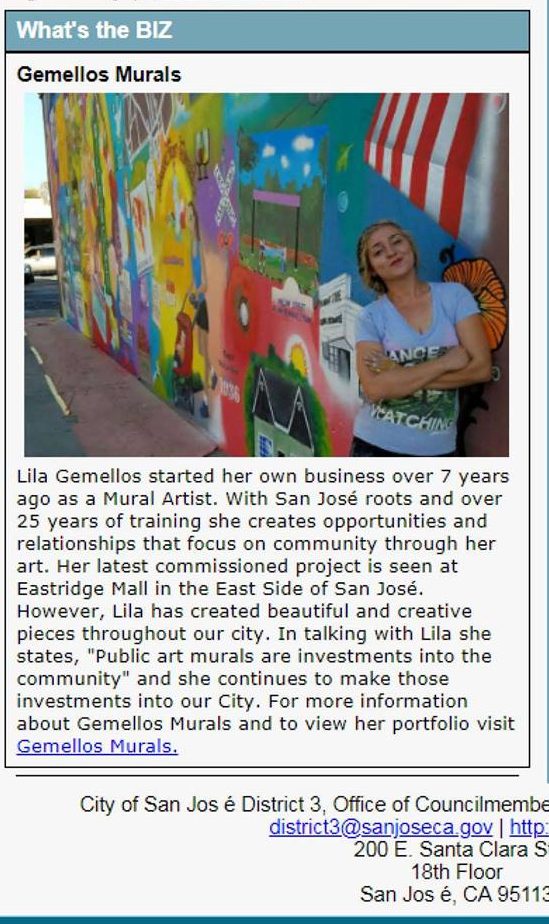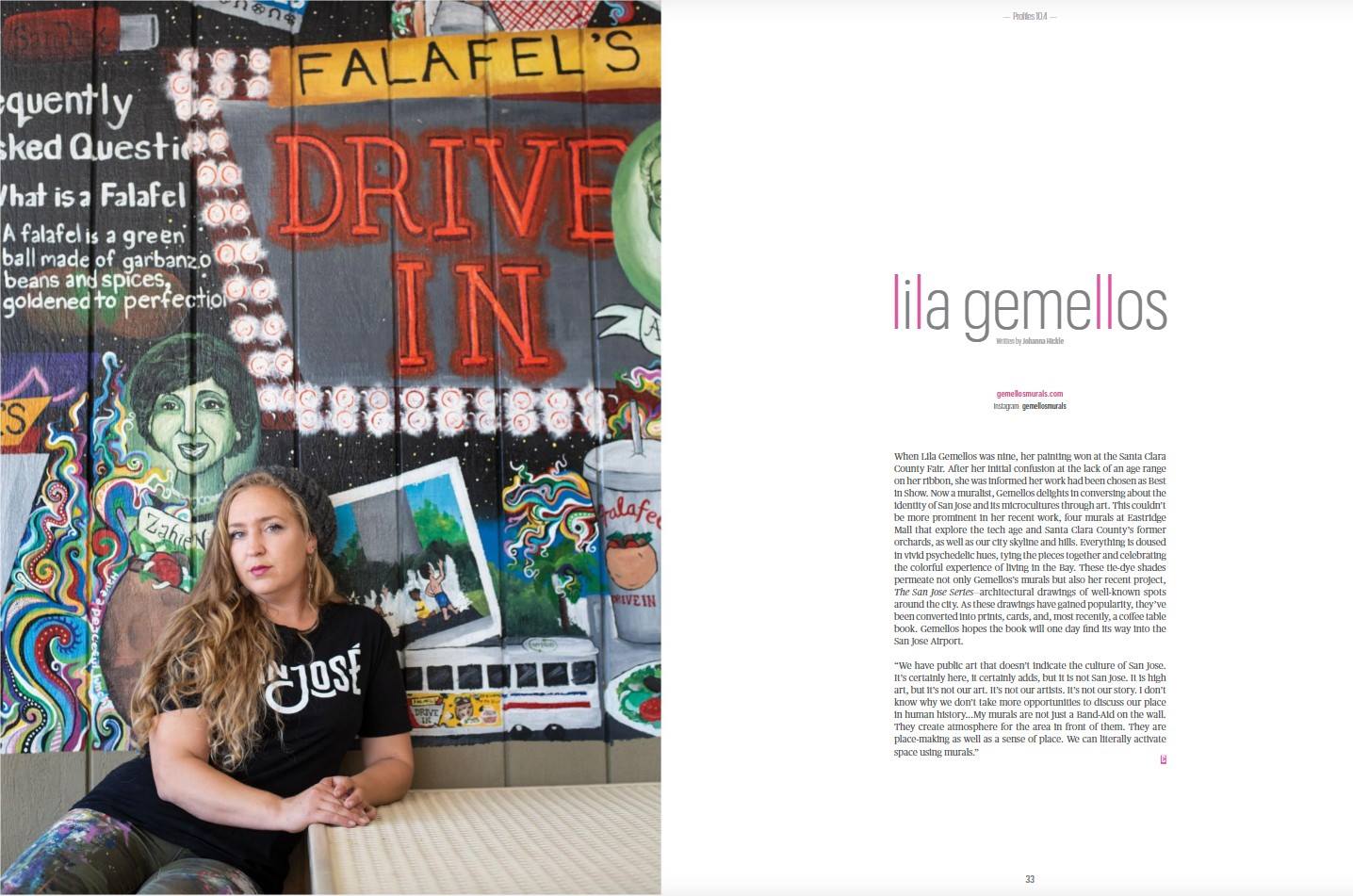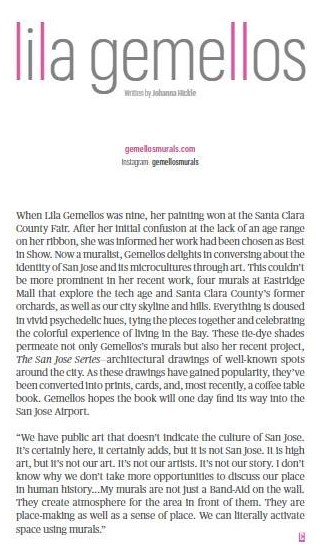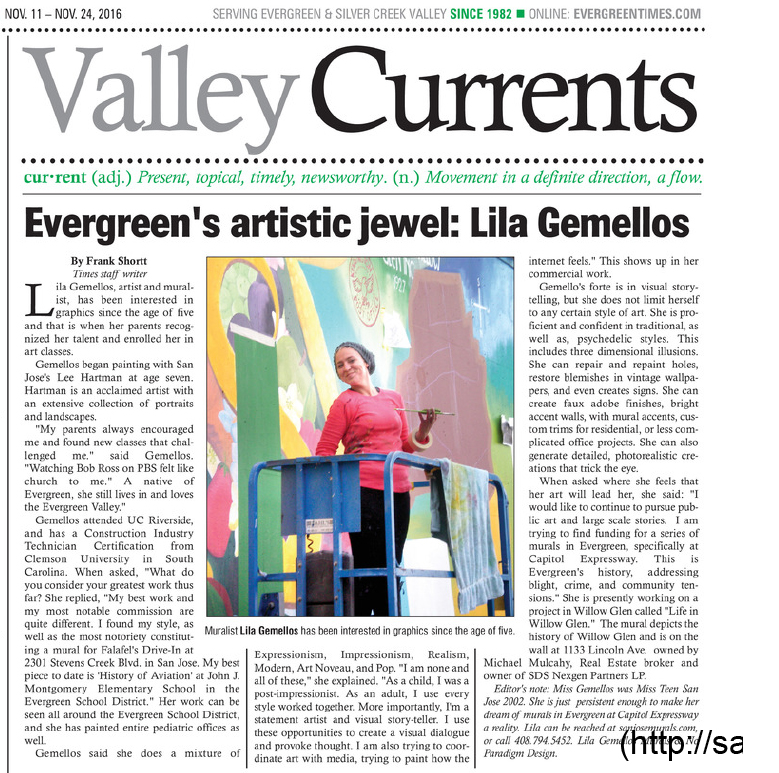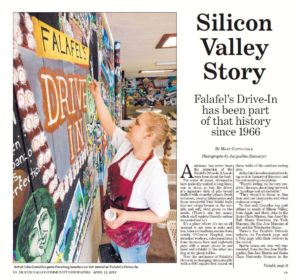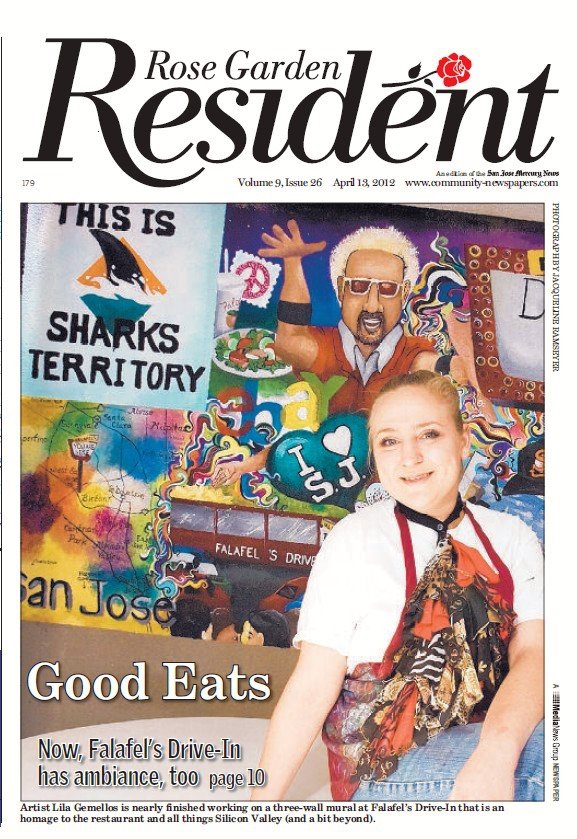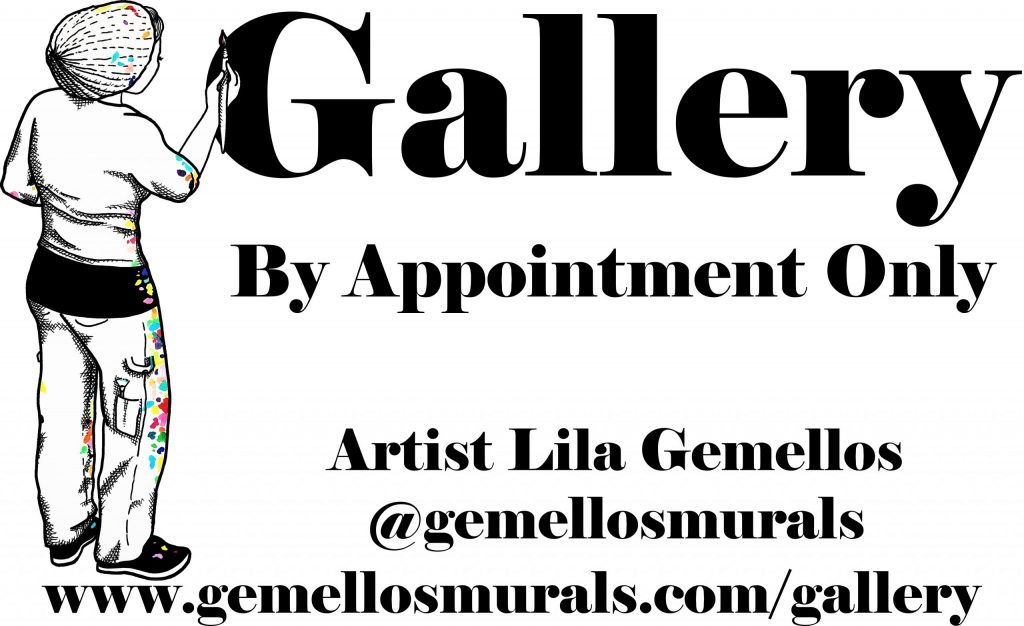Urban Catalyst Unveils New Mural on Fountain Alley Building
/ 3

Fountain Alley just got a lot more colorful. (Photo by Nicholas Chan)
For the people who commissioned the mural, it’s a visual ode to San Jose’s potential. For the artist who painted the piece, it’s a convergence of her own past and present.
Lila Gemellos painted some of downtown’s most prominent landmarks—San Pedro Square, the Bank of Italy and the Museum of Modern Art—on the side of the Fountain Alley building, which is being transformed into a brand new tower by the mural’s patron, Urban Catalyst. She also included images of the developer’s future projects—namely The Icon tower slated for the former Chevron gas station at 147 E. Santa Clara St. and the eight-story hotel planned for the now-shuttered Keystone Restaurant Supply site at San Carlos and Josefa streets.
“This is Urban Catalyst’s story of what they want to see for San Jose: a busy metropolis where the past and present collide, where the experience of San Jose is colored, rich and vibrant,” Gemellos says.
But the city’s story is part of her own narrative, too.

Lili Gemellos says the mural is a love letter to the city that raised her. (Photo by Nicholas Chan)
A San Jose native, Gemellos says she once put her dream of becoming an artist on hold for a career in the real estate industry. So when Urban Catalyst recruited her to adorn the former Lido Nightclub with a vibrant painted cityscape, it intertwined her professional pursuits and personal passion.
Gemellos took her first oil painting class at San Jose’s Museum of Modern Art—to which she pays homage in the mural—when she was 5 years old and began selling her paintings when she was 8. In her late teens, she majored in art studio with a concentration in oil painting at UC Riverside.
But those halcyon days came to an abrupt halt. Just two quarters into her college career, she was diagnosed with a debilitating thyroid disease.
“I almost had to give up my dream of becoming an artist,” Gemellos says. “I got sick and I came home. And I needed workers’ benefits.”
So, she did what she felt necessary to survive, taking up a job as an accounting clerk for a property developer. By night, however, she continued to create and sell art.
Then, another setback.
The economic recession of 2008 devastated the real estate industry, forcing companies like hers to dramatically downsize. She was one of the casualties. The layoff marked a turning point, though. For the first time in a long time, she began seriously considering making a living as a full-time artist.
“I was 25,” Gemellos recalls. “I had the opportunity in the prime of my life to really see if I can make this [art] happen.”
She took plenty of small-time gigs. She painted faces. She made balloon animals at parties. She painted skate and resold them for $100 a pop. “I would go around Starbucks for eight hours a day and pass out cards, discussing what makes my shoes different,” Gemellos says.
The tireless talent-for-hire finally got a break when a customer asked her to paint a mural on a new house in Gilroy. After that, she began to get a steady stream of mural jobs. Among the many murals she’s worked on in the years since are the ones she painted at Falafel’s Drive in, Dove Hill Elementary School and Eastridge Mall.
Now, her latest mural makes for a bright new addition to San Jose’s historic downtown.
Standing in front of the piece on a recent morning, Urban Catalyst Chief Operating Officers Joshua Burroughs admired the dripping paint at the bottom of the mural, which he said denotes the melting pot of cultures that comprise San Jose.
Among many more things the mural represents, Gemellos says, it’s a symbol of opportunity—a sign that things are looking up for the city.
“We’re from paradise—from somewhere that’s economically stable relative to the rest of the world,” she says. “I know some people don’t feel this way, but when you are born here, you kind of win the lottery.”

The dripping paint represents the melting pot of cultures that makes San Jose so unique. (Photo by Nicholas Chan)
https://shoppingcenters.com/article/how-shopping-centers-are-enhancing-spaces-with-murals/
https://www.sccgov.org/sites/d3/Documents/2019%20Fair%20eblast%20for%20web.pdf
Santa Clara Fairgrounds operator gets 20-year agreement (mercurynews.com)
Santa Clara Fairgrounds manager gets 20-year extension despite poor showing
The operator is proposing big changes to the 158-acre fairgrounds

SAN JOSE — Despite persistently drawing criticism for the way it manages the struggling Santa Clara County Fairgrounds, a nonprofit has been granted a new 20-year contract to continue running the 158-acre property.
The Board of Supervisors approved the contract Tuesday at a time when the county also is contemplating redevelopment plans for the fairgrounds at Tully and Monterey roads in San Jose. Supervisor Cindy Chavez has proposed creating a 55-acre public park there and building a museum displaying historic neon signs.
The Fairgrounds Management Corporation also has proposed new uses for the site, including a family entertainment center, hotel and sports facilities for the San Jose Giants, San Jose Earthquakes and USA Cricket.
The 20-year contract allows the county to terminate the agreement at any point with 90-day written notice.
As part of the approval, Fairgrounds Management Corporation must submit a draft master plan by the end of April 2020 outlining its vision for revamping the property, and submit regular reports about its finances, upcoming projects, maintenance and capital improvement plans.
The length of the agreement is meant to provide stability for the Fairgrounds Management Corporation, or FMC, which has operated on year-to-year extensions and three-year contracts since taking over the fairgrounds in 1995.
Supervisor Joe Simitian, who abstained from voting, objected to the contract’s length, especially since the board hasn’t yet decided what it wants to do with the property. He suggested going with a 10-year contract instead.
“I think our board has frankly struggled to reach any consensus on what the property could and should look like beyond the next 10 years,” Simitian said. “Now we’re talking about a hotel, and a minor league baseball park, and office building — these are 30-, 40-, 50-year uses.”
He also pushed the FMC to provide more frequent updates so major proposals won’t get too far along without board input.
“I don’t want proposals showing up that are 95 percent baked, that commit us for 40 years,” Simitian said.
Chavez said she’s comfortable with the agreement because the county can end it anytime. “The way this is structured, it allows for severability at anytime based on the board’s desire,” she said.
The county formed the FMC in 1995 after a previous operator declared bankruptcy. But the organization’s management practices have been criticized for years, including by a grand jury report in 2011 and another one earlier this yea that blamed it for the fairgrounds’ decline.
In its heyday, the county fair ran for two weeks and drew hundreds of thousands of visitors. But as attendance has fallen, the fair has lost money year after year.
Last year, the FMC said the fair turned a corner. Attendance nearly doubled from the previous year and the event turned a profit for the first time in three decades. Though the profit was only $14,000, that was substantially better than the $245,000 loss in 2017.
Although the FMC did not report final attendance numbers or profit or loss figures for this summer’s fair in its 2020 budget proposal and business plan, the plan partially blames the 2019 fair’s “unfavorable financial result” on the Gilroy Garlic Festival mass shooting that happened a few days before.
The organization is projecting a 9 percent growth in its overall revenues in 2020 and says it plans to bolster reserves as its revenues grow.
Chavez has said the county should give the fairgrounds’ new leadership a chance to perform; the current executive director, Abe Andrade, joined the organization in 2018. He was previously the chief financial officer for San Jose’s now defunct redevelopment agency.
Andrade didn’t immediately respond to a request for comment about the new agreement.
This is the fourth time the county has tried to redevelop the property since 1998.
In the early 2000s, the county struck an agreement to build a House of Blues concert venue on part of the site, but that fell through after a recession scuttled financing. Two other attempts in the 2000s to solicit redevelopment proposals didn’t go anywhere.
More than 1,300 people have signed a petition calling on the county to build transitional housing for the homeless at the fairgrounds, but supervisors haven’t taken up that idea. At a meeting in October, the board opted to pursue plans to revamp the fairgrounds as a public event space.
The county has previously built more than 500 units of housing on the site.
Santa Clara’s Uniqueness Put on Display in New Mural
Effort underway to help find solutions to address Bay Area’s housing affordability crisis
By David Louie
Wednesday, October 24, 2018 06:22PM
SAN JOSE, Calif. (KGO) —
Affordable housing– It’s an issue that’s generating lots of complaints but scant solutions. But a concerted effort is underway in the South Bay to identify ways to solve the crisis at the grassroots level and at the ballot box.
Lila Gemellos took a break this week from her work on a mural she’s completing at Santana Row to join housing advocates and others to brainstorm. They are trying to find solutions to address affordable housing. As an artist, she hasn’t always earned enough to pay the rent.
RELATED: Study: It would take 20.5 years of saving to afford down payment for SJ home
“Public art is absolutely how people experience the city, and so we absolutely should be providing affordable housing for artists.”
These are the startling facts about what it takes to afford to rent or to buy a house in San Jose.
“In San Jose, you have to earn $52 an hour to afford the average price rent,” said Kevin Zwick, CEO of the Housing Trust Silicon Valley, “and if you want to try to buy a house, you have to have a salary of over $250,000.”
The Silicon Valley Community Foundation is in the second year of a three-year effort to get people to identify solutions by gathering around tables.
RELATED: American Dream of buying a home may be unattainable for majority of Bay Area residents, study finds
“Then we’re talking with people how they can go into their communities, talk to their neighbors, talk to the City Council people, to try to do a more organic approach to at least getting people talking about this,” said Greg Avis, the foundation’s interim CEO.
Year-by-year, it’s getting tougher for people to come up with down payments to buy a house. Zillow research says it now takes nearly 22 years of saving to come up with a 20-percent down on a median-priced San Jose house. Twenty years ago, it took 10 years of saving.
Voters on Nov. 6 also are going to asked to approve potential solutions– two statewide propositions and in San Jose, a local measure V, that will raise billions of dollars for affordable housing and for homelessness prevention housing for individuals with mental health issues.
https://www.codeforsanjose.com/heartofthevalley/about.html
https://abc7news.com/realestate/finding-solutions-to-address-the-bay-areas-housing-affordability-crisis/4549753/
Here’s what’s new in Eastridge’s $15 million makeover
Cornerstone for the Arts Awarded to Eastridge Center
What’s the Biz Recognition
District 3, Office of
Councilman Raul Peralez
September 23rd, 2018
CONTENT MAGAZINE FEATURE – August 2018
Photography by Daniel Garcia
Here’s what’s new in Eastridge’s $15 million makeovernew play area for kids is part of a makeover for Eastridge Shopping Center in East San Jose, which will have a grand re-opening April 6-8. (Sal Pizarro/Bay Ar
By Sal Pizarro | spizarro@bayareanewsgroup.com | Bay Area News Group
PUBLISHED: April 4, 2018 at 11:53 am | UPDATED: April 4, 2018 at 1:10 pm
Before Valley Fair and Santana Row, Eastridge was the queen of the malls when it opened in 1971. Once the largest enclosed shopping center in the West, it’s safe to say Eastridge relinquished its lofty status long ago. But the mall is approaching its late 40s with a new look and approach, courtesy of a $15 million makeover.
Since Pacific Retail Capital Partners purchased the East San Jose shopping center last year, it has embarked on a strategy to make Eastridge Center more relevant to the community around it. That effort included bringing in artist Lila Gemellos to provide a sense of place through a series of murals in the mall and holding a Taste for the Space contest to give a local food truck operator a shot at locating an eatery inside the mall. Chefs Lai Chao, Ryan Gallego and Jason Artajos from Trifecta Cooks won that contest will be joining the mall’s food lineup in August.
Among Eastridge’s new features are a kids’ play area, a family lounge with a TV where kids can chill out, and upgraded interior touches that include more seating, greenery, a bubbling fountain and a cherry blossom tree. The Eatery food court includes new restaurant offerings, community tables with charging stations, and kid-size chairs in a family seating area called the Honeycomb.
All that work will be celebrated with a three-day “grand re-opening” that starts Friday and has a different focus each day. Food will be the big thing Friday, with a 1 p.m. ribbon cutting followed by a 2 p.m. panel on San Jose’s food scene, plus chef demos, food trucks and music. On Saturday, art will be in the spotlight, with dance and music performances every hour from 10 a.m. to 6 p.m., a makers market, an open mic showcase and a community mural painting. The festivities wrap up Sunday with a focus on families, with Coffee with a Cop at 11 a.m., an appearance by SJ Sharkie at noon, and a family expo from 1 to 5 p.m. that includes bounce houses, face painting and a meet-and-greet with DreamWorks’ Trolls.
For more information, go to www.eastridgecenter.com.
San Jose artists sought to paint murals on park water vaults
City leaders intend to enlist San Jose artists in an effort to wipe out some of the blight in TJ Martin and Jeffrey Fontana parks by painting vibrant art murals on a dozen water retention vaults.
They say the murals would add a dash of color to the two parks, which have been plagued over the years with overgrown weeds, damaged soccer fields and irrigation systems ruined by rodents.
The concept is similar to other public art projects such as brightly painted utility boxes scattered throughout the city.
The concrete vaults, owned by the Santa Clara Valley Water District and used to manage excess stormwater runoff to prevent flooding, will give local artists 12 blank canvases of different sizes to cover and stylize with various images, shapes and colors.
Linda Wilson, a past president of the Martin Fontana Parks Association, said in an interview the idea for the art project was hatched about five years ago when residents approached the group to “ask if anything could be done about these because they were really ugly.” But nothing happened after it was learned the murals would have to be maintained for as long as the vaults stood.
Councilman Johnny Khamis, whose district encompasses the parks, told the Resident he’s “answering the call from the community to beautify these vaults” after fielding multiple complaints about them.
One of his staff members raised the idea last year when city parks and cultural affairs officials asked what Khamis wanted to do with $25,000 from leftover development fees earmarked for public art.
“We said the community has been interested in doing something about these water retention vaults because they look ugly,” Khamis said.
After the San Jose City Council approved the project, Khamis’ office applied for encroachment permits from the water district at the end of March to paint the vaults. The project was presented to the community at a public meeting on June 3 attended by an several dozen residents, including Wilson.
“We saw some really nice styles in the presentation,” Wilson said, adding that she doesn’t prefer any particular style so long as the artists’ work reflects the park’s natural setting.
“I think most of the people who use the parks like to see represented, in whatever style, what you see around you in the park,” she said.
Artist Lila Gemellos, whose murals can be found at Falafel’s Drive In and in Willow Glen, says she sees a painted path toward beautification for more neighborhoods outside the city’s center. Supporting local artists, discouraging graffiti and instilling a sense of community pride are just some of the project benefits Gemellos recently discussed with Khamis.
“Murals are such a cost-effective public art expense in terms of what they do for communities and how they can acknowledge and communicate our culture,” Gemellos said. “We could make our own way and our own identity.”
The city will start accepting artists’ applications around the end of July, then notify selected artists in early 2018. For more information, contact the San Jose Office of Cultural Affairs at 408-793-4344.
Preserve Willow Glen, San Jose’s history
I was surprised to read the article regarding the ongoing battle over the Willow Glen Trestle that neglected to mention the fact that its $1 million replacement was purchased years ago. Friends of the Willow Glen Trestle are not only fighting to preserve history — they are also fighting the embarrassment that will come to the elected official(s) who purchased a replacement without doing their due diligence.
Even the newest mural by Lila Gemellos suffered as a result of the politics at play: the photo in your coverage on Nov. 16 includes the Willow Glen Trestle next to a railroad crossing sign. Gemellos was instructed to paint over it. Now it features Shakespeare in the Park with “taped” corners on the replacement. Gemellos listened to her employer, but maintained her integrity. Notice any other “taped” depictions? Kudos to her.
Willow Glen and San Jose have history, folks. Let’s hold onto it, even if it means we’ve got a steel bridge to sell.
S. Paige Liu
San Jose
Community News
Mural takes viewers on a trip down memory lane

A new mural on Lincoln Avenue in Willow Glen was created by artist Lila Gemellos, who also painted the wrap-around mural at Falafel’s Drive In.
A newly completed mural on Lincoln Avenue tells many old stories about Willow Glen.
The vibrant, rainbow-hued piece designed and painted by San Jose artist Lila Gemellos covers the north side of the BevMo building at 1133 Lincoln Ave., where it showcases “the culture taking place uniquely here in Willow Glen.”
Historic signs like the Garden Theatre’s and depictions of fondly remembered long-gone businesses such as the Willow Glen Basket Factory weave a tale of the neighborhood’s past, present and future. Smaller flourishes of iris and lily flowers and fruits like peaches and grapes connect to the agricultural roots of the Valley of the Heart’s Delight. Popular local pastimes including bocce ball and holiday traditions like the trolley car and a sparkling Christmas willow tree are also paid homage in Gemellos’ work.
“This is all derived from stories here,” Gemellos told the Resident. “Every single one of these fruits come from a neighbor here back in the 1800s. Some of these are pictures of family photos,” such as a portrait of Antonio Sunol.
“We’ve tried to capture it all throughout time and say something prominent about the community at large,” she added.
The mural–paid for with $12,500 from the San Jose City Council District 6 office budget–started going up late last month and immediately grabbed residents’ attention.
“The second that I painted in the old Bergmann sign…people started slowing down and taking notice what this was and that this was really about them,” Gemellos said.
Numerous residents already have taken their photo in front of the mural.
Willow Glen High School junior Julio Cerda and his girlfriend stopped by during an evening stroll to marvel at Gemellos’ work, which he called “beautiful”.
“Most of the stuff is still here,” Cerda said. “It’s inspiring. I don’t know how to explain it, but it makes me happy.”
Gemellos said that although any part of the mural will give visitors a memorable and eye-catching visual, there’s one spot with a black and white backdrop of 1950s-era Lincoln Avenue that she specifically designed as a postcard-perfect shot.
“It makes me teary eyed when people come up and drop a handbag and start posing for pictures,” she said. “That’s the whole point–come and enjoy.”
In addition to serving as a fun and interactive piece of art that tells the history of Willow Glen, the mural serves a more practical purpose.
“You can never get lost while you’re here,” Gemellos said, pointing to a map of Willow Glen that she added near the top with a pinpoint of the mural’s location. “This map points south up and north down because you’re pointed this way (south), so if you’re ever lost and stumbling around downtown Willow Glen, stumble here and you will find your way home.”
Silicon Valley Story
April 12, 2012 at 2:03 pm
Ambiance has never been the attraction of the Falafel’s Drive-In. It has always been about the food.
For some 46 years, aficionados have patiently waited in long lines, rain or shine, to buy the drive-in’s signature dish of pita bread stuffed with crunchy lettuce, fresh tomatoes, creamy tahini sauce and those wonderful fried falafel balls that are crispy brown on the outside and soft, vivid green on the inside. (There’s also hot sauce, which staff squirts liberally unless requested not to.)
It’s a place where it’s not at all unusual to see men in suits and ties, bikers in leathers, nurses from nearby O’Connor Hospital, construction workers, sales associates from Santana Row and high-tech guys with a smart phone in one hand and a falafel in the other sitting at the picnic tables.
Now the ambiance of Falafel’s Drive-In is changing dramatically with a 600-square-foot mural on three walls of the outdoor eating area.
Artist Lila Gemellos started working on it in January of this year, and it’s now nearing completion.
“They’re letting me be very creative,” she says, describing her work as “a collage and symbol style.”
“They wanted to focus on San Jose and our landmarks and what makes us unique.”
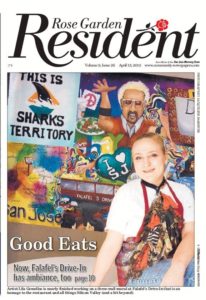 To that end, Gemellos has paid tribute to much of Silicon Valley, from Apple and Steve Jobs to the Santa Clara Mission, San Jose City Hall, Mount Hamilton, the Tech Museum, the San Jose Museum of Art and the Winchester House.
To that end, Gemellos has paid tribute to much of Silicon Valley, from Apple and Steve Jobs to the Santa Clara Mission, San Jose City Hall, Mount Hamilton, the Tech Museum, the San Jose Museum of Art and the Winchester House.
There’s the Falafel’s Drive-In website, its Facebook page and a Yelp page with their reviews in the mural.
Sports teams are also well represented, from the San Jose Earthquakes, San Jose Sharks and Santa Clara University Broncos to the San Francisco Giants and the Oakland A’s.
In the three months she’s been working on the mural, Gemellos has listened to patrons and engaged in multiple conversations. Many have made suggestions of what they’d like to see added to the mix of images, and she’s used many of them.
“Everybody has been super positive,” says Gemellos, who works in the morning and afternoons, taking a break around lunch time when the lines are long and the patio seats are filled.
Particularly fascinating are Gemellos’ tributes to the Falafel’s Drive-In itself, from “What’s a falafel?” and “What’s Inside the White Sauce?” to a portrait of founder Anton Nijmeh. The latter painting is positioned so patrons can stand next to it for a photo if they like.
Nijmeh bought what was then the Snow White Drive-In in 1966, initially keeping the name.
Along with the standard fare of cheeseburgers, hot dogs, fries and milkshakes, he soon slipped in a favorite Middle Eastern food from his homeland. Made from his recipe using chickpeas, Nijmeh would offer a free falafel ball to customers with their orders.
“He would tell people, ‘Try it, you’ll like it,’ and he’d give it to them for free to give it a try,” says Joanne Boyle of her father.
Hamburgers and hot dogs remain on the menu, but as the customer base for his falafels grew and grew, Nijmeh changed his eatery’s name to Falafel’s Drive-In.
Often called a “culinary visionary,” Nijmeh’s timing was perfect.
Falafels are vegetarian, and they were exotic at that time. They remain very affordable. Students from San Jose State University and San Jose City College became loyal supporters.
Even though falafels eventually popped up on other menus, fans of Falafel’s proprietors still consider theirs the standard of excellence.
Zipora Peri has been making the pilgrimage there since 1975, first from her home in San Carlos and now from Palo Alto.
“They were the only falafel place in the Bay Area,” she says to explain why she first stopped there.
“I’m from Israel, and Israelis love falafels; they are the fast food of the Mediterranean.”
Peri says that while falafels and other Middle Eastern favorites are now easier to find, she still considers the ones at Falafel’s Drive-In “the best in the Bay Area.”
She is particularly appreciative of the courtesy she finds there.
“He’s Palestinian and I’m Israeli, and Israel and Palestine are not on very good terms in the Middle East, but here they are extremely nice,” she says of Nassif Grayeb, who is most often the person taking orders at lunch time.
“I wish it would be the same thing in Israel so there would be peace and not war,” Peri says.
Food Network personality Guy Fieri shined a major spotlight on Falafel’s Drive-In in his series “Diners, Drive-Ins and Dives” and wrote a glowing review of it in his book of the same name, so he’s featured prominently in the mural.
Falafel’s Drive-In is nearing 2,000 reviews on Yelp, almost all positive with frequent nods to the special combo of a falafel and a banana shake.
Founder Nijmeh died in 2006 at the age of 76, but he had handed over the reins to his sons and daughters well before that, and they continue to run the popular eatery.
“All the kids are still here, sons Hani, William and Jack Nijmeh and daughters Deanna Grayeb and Joanne Boyle,” says Nassif Grayeb, husband of Deanna and an employee for more than 25 years.
Boyle, born two years after her father bought the Drive-In, essentially grew up there.
“From the time I could reach the cash register, I was working, probably around 10 or 11,” she says.
“I’m still working there.”
Grayeb is candid about how Falafel’s was before they decided to add an awning and screen to the outside and new paint on the inside.
“The place was getting old, but we didn’t want to change it too much, as it’s unique,” he says.
“A lot of people came here on their first date, and for them it’s nostalgic. They brought their kids and now they bring their grandkids.
“People would sit in the rain and be uncomfortable, but they loved it. Now we have heaters and awnings and it’s more comfortable.”
It was Boyle’s husband and daughter who first suggested Gemellos was the right artist to do a mural after seeing her work at Chaboya Middle School in the Evergreen area.
Now Gemellos is putting the finishing touches on her mural, and when the acrylic paint is dry, enough, she will put a graffiti-proof seal over it.
“Nobody has defaced it at all,” she says. “It’s really exposed at night, but I think the community protects it.”
For Gemellos the commission has been a dream job.
“It’s one of my mom’s favorite lunch spots, and when I worked downtown, I’d drive down and wait in the long lines,” she says.
A native of San Jose, the artist worked in construction and property management for five years, expressing her artistic side by drawing detailed, colorful designs on shoes and selling them.
“I’ve had a wonderful experience here,” Gemellos says. “I love the food. I love the place. I love the project.”
Lila Gemellos’ work can be seen on www.noparadigmdesigns.com.
Falafel’s Drive-In, 2301 Stevens Creek Blvd., San Jose, open 10 a.m. to 8 p.m. Monday-Saturday and 10 a.m. to 6 p.m. Sunday. www.falafelsdrivein.com, 408.294.7886.
Press Releases
October 20, 2016
gemellos paints mural on lincoln ave
SOCIALLY CONSCIOUS ARTIST MAKES MOVE TO PUBLIC PROJECTS
Lila Gemellos, 31, has been cutting her teeth in East San Jose and Evergreen public schools, painting meaningful murals that abate graffiti. By adding to the school’s culture, Gemellos’ art is adopted by the Community, never having to paint over, touch up or wash out a mural.
With her most popular commission at the Falafel’s Drive In, Gemellos looks to break into the Public Art scene and make a larger splash with her statement murals. Well-known Willow Glen businessman, Michael Mulcahy, found the canvas within his Lincoln Avenue portfolio. A grant, made possible by Councilman Pierluigi Oliverio, to the Willow Glen Business Association, allows Lila Gemellos to add to the culture of Downtown Willow Glen. Along with several other investments to Public Art on Lincoln Avenue, Councilman Oliverio is a true supporter of the Arts.
Gemellos and Mulcahy plan to bring a Historical View of Willow Glen to life at 1133 Lincoln Avenue. “In taking a survey of the murals along Lincoln, residents love the Art already installed but lament not having something that expresses their rich history. While acknowledging the present culture, we can also give people a sense of nostalgia and keep that heritage alive,” says Gemellos. The artwork itself is entirely inspired by Downtown Willow Glen’s culture.
Improvements to Lincoln Avenue’s traffic management, made permanent in late June 2016, make the mural an even better investment to building and surrounding walking Community. Along with roadway improvements, the mural should glamorize Lincoln Avenue’s more walkable route through the heart of Willow Glen’s commercial district.
Lila Gemellos
Gemellos Murals
408-794-5452










